
Atlas F1 Senior Writer
Although Ferrari is still winning most of the races, Honda is the manufacturer whose gathering strength constitutes the greatest long-term threat to the dominance of Ferrari. Thomas O'Keefe assesses the evidence as to how the inevitable confrontation is going and what happened the last time the Tifosi and the Samurai squared off at Monza
The anti-Honda drumbeat first became evident at Monaco. The Little Red Book describes Takuma Sato's bold move at the start, rubbing wheels with Michael Schumacher to rocket himself to fourth place, as follows: "at the start, both Ferraris were 'ambushed' by Sato, who got ahead of them... Michael's car took a knock on its right front wheel from the Japanese driver." Sato's engine blown-up is also recorded for posterity in delicious and gloating detail in the Little Red Book: "On lap 3, the Honda engine blew up, putting out a thick cloud of smoke, creating a dangerous visibility problem for those behind."
At Nurburgring, the ever-imaginative Sato took on the other prancing horse, Rubens Barrichello, in an audacious (and perhaps overly optimistic) outbraking passing move on Rubens at the Mercedes turn, which challenged Rubens for second place. Here is how that lively move was viewed through the rose-colored glasses at Maranello: "on newer rubber, Sato caught up with the Ferrari man and, at the start of lap 46 tried to pass at the first corner. The two cars collided with the Japanese driver coming off worse, having to make a pit stop for repairs." Later on in the post-race analysis, Barrichello, not himself renowned for making energetic passes, followed the Company Line and deemed Sato's move "amateurish." The Little Red Book contented itself with revelling in yet another cooked Honda lump: "Sato's race ended on lap 48 when his Honda engine blew up as it crossed the line."
Sato's presumptuous behavior of actually trying a few overtaking moves on the two Ferraris and on Ralf Schumacher at Bahrain, another member of the extended Ferrari family, was sufficiently distressing that the traditionally perfunctory drivers meeting held on Friday after practice at the Canadian Grand Prix (where Sato managed to spin at Champions' Wall and keep going during qualifying) went on for over an hour as certain drivers allegedly made certain comments directed toward a certain jockey-sized Japanese driver's spirited moves. The Montreal drivers meeting to box Sato's ears went on so long that Jarno Trulli was late for his appearance at a ballroom full of Grand Prix Tours people waiting to hear from him in Downtown Montreal.
Ross Brawn, who usually carries himself as very much above the fray and is given to wondering out loud why the Other Teams cannot catch up, uncharacteristically joined in the Honda bashing when BAR-Honda brought a front-axle torque transfer system to Friday practice for the German Grand Prix, opining imperiously from his top perch that lesser lights like Geoff Willis, BAR's technical director, simply don't know their stuff: Said Brawn: "I guess Geoff was not around in those days [when Renault and Benetton had a mechanical torque transfer system] and he came up with a system that clearly contravened the clarifications that the FIA had given the teams a few years ago. We were a bit shocked about it." I'll bet.
To my mind, all of this is shaping up in a way that will finally bring those two motorsports titans – Honda and Ferrari - into direct confrontation with one another for the first time in their history, enlivening Michael Schumacher's waning years at Ferrari.
Incredibly, the current era is really the first time in 40 years that Honda and Ferrari have faced each other on an equal footing. In Honda's most recent glory years of the late 1980's and early 1990's (what Honda called the "Second Generation"), Ferrari was usually in the doldrums. And in Honda's first foray into Grand Prix racing in 1964 – 1968 (the "First Generation"), there was another mismatch with the fledging Japanese team participating in just three races in 1964, its inaugural year in the sport, a year that Ferrari had finally scratched out a winning season over Lotus and BRM, when John Surtees won both the World Drivers' and Constructors' Championship for Enzo Ferrari.
Before turning to the Honda/Ferrari battle during the 1967 Italian Grand Prix, some background on John Surtees, the one man in all of the history of Formula One to have been both a Tifosi and a Samurai.
John Surtees, now 70 years old, goes back a long way in the motorsports business. The son of Jack Surtees, a noted sidecar motorcycle racer himself and the owner of a garage, young John grew up racing motorcycles against another Grand Prix legend. Bernie Ecclestone was four years older than John and, always the entrepreneur, sold parts to Jack and John Surtees and other bikers to finance his own racing activities, first racing motorcycles and then Formula 500cc Coopers. Bernie ultimately had a crash in 1951 at Brands Hatch in a Cooper, and although that ended his transition from two wheels to four, he has done well since!
Surtees did rather better in converting himself from a bike rider to a car racer. A 500cc World Motorcycle Champion by 22 years old and then four times over (1956, 1957-59) before he ever competed in an open wheel car race, the hallmark of John Surtees was his perfectionism, dedication and the honesty with which he approached his many roles in motorsports: first as driver for other teams, both sports cars and Formula One, then as a constructor/entrant when he formed his own Surtees Grand Prix team, drawing on his engineering background, which was honed from a young age when he absorbed what he learned around his father's garage and then went on to a formal engineering apprenticeship. When Honda Motor Company was looking for a driver who could help the company get Honda's mid-1960's First Generation Grand Prix Program back on track, it was to fellow motorcycle racer Surtees that Honda turned, and Surtees delivered.
Ironically, Surtees had been with the opposition in his motorcycling days, racing Norton and MV Augusta motorcycles and not a Honda, but Honda Research and Development Chief Yoshio Nakamura and Soichiro Honda himself admired Surtees and felt a certain kinship to the Englishman because Honda itself was making the transition from a motorcycle racer to Formula One racer, as Surtees had done for himself so successfully.
Although quiet and modest, Surtees had taken the Formula One community by storm when he first showed up on the scene. In his first Formula Junior race on March 19, 1960, driving a Cooper T52 BMC loaned to him by Ken Tyrrell at Goodwood, Surtees put the Cooper on pole in a field that included Jim Clark's Lotus 18 Ford; this in Surtees' very first open-wheel race!
After some early travails, by the 1964 season Ferrari had regained some of the ground lost after its 1961 Championship Season with the Ferrari 158 "Aero" V8 and, in a fiercely contested championship between Surtees for Ferrari, Graham Hill for BRM and Jim Clark for Lotus which went down to the very last race of the season, the Mexico Grand Prix, a 2nd place by Surtees clinched both the World Drivers' and Constructors' Championships over Graham Hill by the slim margin of 1 point.
In addition to being a championship season for Surtees, 1964 was the year Honda made its debut in Formula One in its off-white painted RA271 with a red Rising Sun on the scuttle, participating in only three races, but all at the most demanding of Grand Prix circuits: Nurburgring, Monza and Watkins Glen. Amazingly, although John Surtees won the 1964 Italian Grand Prix at Monza for Ferrari, Ronnie Bucknum's powerful Honda RA271 fuel-injected 1.5 litre V12 showed its promise, Bucknum qualifying in the top 10 and running as high as 5th on the high-speed Monza circuit before retiring after 12 laps due to overheating and brake problems. In due course Honda would conquer the historic Monza track six times, but not so in 1964.
In 1966 Surtees was the victim of dissension within the Ferrari team, which seemed to be its eternal character trait in that era, and his performance and that of the team suffered as a result. Enzo Ferrari was focused on the sports car racing battle for supremacy against Ford Motor Company's GT40, which Ford would win in 1966 when the Ford GT won at Le Mans in a big way, finishing 1, 2 and 3. Although Surtees led the 1966 Monaco Grand Prix in the new 3.0 litre Ferrari 312 and won Spa with the same V12 engine on June 12, 1966, Surtees had a falling out with Ferrari's Sporting Director, Eugenio Dragoni, with Surtees preferring to race Ferrari's reliable 2.5 litre "Tasman" V6 engine rather than develop the newer V12.
On June 22, 1966, 10 days after Surtees' had won for Ferrari at Spa, the Commendatore and Surtees met for lunch at the Ristorante Cavallino across from the Ferrari factory gates at Maranello, and when the lunch was over so were Surtees' days at Ferrari. But the two men parted friends, as Enzo Ferrari said at the time: "Let's think of the proud times of our mutual successes and not the sad moment of this separation." And as Surtees would recall years later: "That was costly to Ferrari and costly to me. I believe we lost one or two World Championships as a result." And indeed, Ferrari would not win another championship until 1975.
In Japan, Yoshio Nakamura and the Honda engineers worked to improve the 3.0 litre V12's reliability and to increase horsepower, achieving 395 bhp at 8,000 rpm initially and ultimately improving output to 405 bhp at 10,000 rpm.
Meanwhile, back in Slough at the factory, the RA300 chassis was taking shape in record time, an amalgamation of a Japanese technology which had proved itself in America. Drawing heavily upon Lola's successful T190 Indianapolis chassis design, Surtees, working with Honda's chassis designers from Japan, adapted the Lola T190 where necessary, attempting throughout to lighten the chassis to cure the excessive weight problem Surtees was experiencing in the RA273, which was robbing the car engine of power and making the car difficult to handle. The front part of the car, including the nose cone was all-Lola, but from there on back the rear bulkhead subframe supporting the engine, and the suspension requirements were all Honda. The lightening of engine and chassis made the RA300 at Monza 285 pounds lighter than the RA273 at Monza the year before.
Pushing the RA300 to completion, the Honda passed up participation in the Canadian Grand Prix, but was ready to introduce the "Hondola" (as it was quickly dubbed by the press) at Monza for the Italian Grand Prix on September 10, 1967. It was reported that the RA300 was built in six weeks and it had run only a few laps at Goodwood before being transported to Italy. As a back-up, Surtees had the RA273 available as a spare.
And Surtees almost needed one because, during Friday's practice at Monza, the front anti-roll bar mountings of the new car began to fail on the rugged Monza circuit; that car was sent back to the pits for repairs while Surtees practiced in the old RA273. By Saturday's qualifying, the mountings had been strengthened and the RA300 qualified in 9th place in an 18-car grid, not a particularly promising place to start.
But in the race, peculiar things happened. Begun in confusion on the part of the starter, which led to a jumbled start with Gurney's Eagle coming through from 5th on the grid to be leading the race after lap 1. By the end of lap 5, however, the natural order of slipstreaming at Monza had begun to prevail, with polesitter Jim Clark out ahead on his own and then his teammate Graham Hill's Lotus, Denis Hulme's Brabham and Jack Brabham's Brabham in one pack and Bruce McLaren's McLaren, Chris Amon's Ferrari, the Honda of Surtees and Jochen Rindt's Cooper all in a line in a second group.
With Jim Clark going a lap down to replace a flat tire and Hulme going out with engine trouble, by lap 34, half distance, the Honda and the Ferrari were third and fourth behind Hill and Brabham, Surtees leading Amon only by inches.
By lap 50 of the 68 lap race, Amon and the others behind Surtees' slipstream had pitted or retired and the Honda was on its own in 3rd place and now able to close the gap to Jack Brabham in 2nd place. The gap from Brabham to Hill was 55 seconds on a circuit where a lap took 1 minute 43 seconds.
Meanwhile, although Clark had been a lap down, he was rapidly unlapping himself and in the process towing his teammate Hill, then the leader, around the track and gradually coming up on Rindt, then in 4th place. After Rindt was lapped, Hill had the remainder of the top three out in front of him, first Surtees, now in 3rd place, and then Brabham, still with a reasonable lead over Surtees' Honda.
On lap 59, Graham Hill's engine let go and the configuration of the race changed again. Brabham came around in the lead but in the interim Clark was completing his charge back through the field and passed the Honda for 2nd place; setting out in pursuit of Brabham. When Surtees was passed by Clark's Lotus, he tucked the Honda in behind the Lotus and the two cars closed down on Brabham together.
On lap 60, Clark caught and passed Brabham in the Curva Grande, amazingly having made up a full lap on a circuit over three and one-half miles long.
With only 3 laps to go, by lap 65, Clark had shaken Brabham from his slipstream but now Brabham had fallen into the clutches of Surtees' Honda. As they started the last lap, Clark was still leading but the overall gap covering all three cars – Lotus, Brabham and Honda – was down to 1.8 seconds. Something was wrong with Clark's Lotus.
Surtees could hardly believe his good fortune but as he rocketed down the Rettifilo Centrale straightaway after the Ascari Curve he was worried that Brabham might be able to outbrake him into the critical last corner before the main start/finish straight, Parabolica. Surtees knew there was still cement dust left that had been put down after Graham Hill's engine blew up at the end of the straight just where the Parabolica curve began. Surtees stayed to the left (which was the safer side of the track) coming into the braking zone and forced Brabham to choose: either follow Surtees through Parabolica and try to slingshot by the Honda before the finish line or brake inside of Surtees at Parabolica.
Surtees had guessed correctly; Brabham moved to the right, the Brabham and the Honda entering the braking zone together with Brabham hitting the cement dust, losing traction and sliding to the outside of Parabolica, permitting Surtees to cross behind the Brabham and dive inside the corner, leading the Brabham as they exited Parabolica and headed down the wide and long Monza front straightaway. As they came up on the finish line, Brabham pulled out of the Honda's slipstream and tried to pass and almost got alongside Surtees but not before Surtees reached the checkered flag, the margin of victory being clocked at only 0.2 of a second.
Still a hero of the Italian fans from Surtees' days at Ferrari and from racing the Italian MV Augusta motorcycles, the crowd – which had witnessed the race-long contest between Amon's red Ferrari and the white Honda - went wild and celebrated Surtees' victory for Honda as though it had been for the team from Maranello. Surtees' triumph at Monza in 1967 was Honda's last victory in Formula One as a constructor, and another highlight of its First Generation in Formula One.
Honda would enjoy one last success at Monza a year after the Ferrari/Honda struggle of 1967. In the 1968 Italian Grand Prix, Surtees achieved Honda's one and only pole position as a constructor at the prestigious track where the Honda always seems to go well and, for our sake, we can only hope that the magic of Monza brings out the best in Honda once again this year.
For all of their cultural and historical differences, the two manufacturers – Honda and Ferrari – share one common trait that no less a qualified observer than Ferrari President Luca di Montezemolo pointed out: "Both [companies] were founded by extraordinary individuals who loved motor racing and were committed to technical innovation."
Let us hope that we will see that common heritage on full view again on the wide and long main straight at Monza, where there is room enough for the Tifosi and the Samurai to go stride for stride.
Make no mistake about it: while Honda has yet to win its first Grand Prix in its current assault on Formula One, the Japanese giant is the manufacturer Ferrari most fears due to its phenomenal track record. The last time Honda Motor Company set its sights on Formula One: six Constructors' Championships from 1986-91 in the back of either a Williams or a McLaren driven by the pre-Schumacher champions of the sport: Prost, Senna, Piquet, and Mansell. As amazing as the Jean Todt era at Ferrari has been, Honda's phenomenal success before leaving Formula One after the death of Soichiro Honda in 1991 is fresh in the minds of the Men from Maranello. It may not be apparent on television, but you can feel that buzz in the paddock.
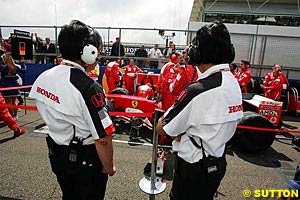 How do I know that Honda in its Third Generation is beginning to get on Ferrari's nerves? You can see it in the way both Jean Todt and Ross Brawn treat BAR-Honda's drivers and the team generally when BAR-Honda has the audacity to do, or attempt to do, something that Ferrari sees as Honda acting as a pretender to the throne. The Rosetta Stone in following this gathering storm is the coveted Little Red Media Book that Ferrari makes available to journalists on race weekends that recaps each race.
How do I know that Honda in its Third Generation is beginning to get on Ferrari's nerves? You can see it in the way both Jean Todt and Ross Brawn treat BAR-Honda's drivers and the team generally when BAR-Honda has the audacity to do, or attempt to do, something that Ferrari sees as Honda acting as a pretender to the throne. The Rosetta Stone in following this gathering storm is the coveted Little Red Media Book that Ferrari makes available to journalists on race weekends that recaps each race.
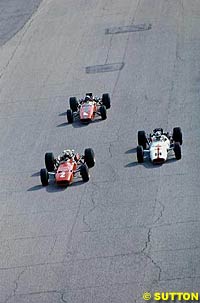 Indeed, the only real occasion up to this current season when Honda and Ferrari challenged one another was at Monza, in 1967, when Ferrari's Chris Amon duked it out with ex-Ferrari champion Surtees, who was by now both Honda's lead driver and much more, Honda having in effect subcontracted their last two seasons in the First Generation to Surtees and his factory in Slough, England.
Indeed, the only real occasion up to this current season when Honda and Ferrari challenged one another was at Monza, in 1967, when Ferrari's Chris Amon duked it out with ex-Ferrari champion Surtees, who was by now both Honda's lead driver and much more, Honda having in effect subcontracted their last two seasons in the First Generation to Surtees and his factory in Slough, England.
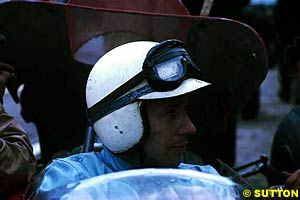 In 1963, after time spent at Lotus and Lola, John Surtees got his big break when Enzo Ferrari hired him to replace Phil Hill, the American 1961 Formula One Champion for Ferrari. Thus began the prickly partnership between the strong-willed and principled Surtees and the legendary Commendatore who seemed to regard drivers as necessary evils who should be seen but not heard.
In 1963, after time spent at Lotus and Lola, John Surtees got his big break when Enzo Ferrari hired him to replace Phil Hill, the American 1961 Formula One Champion for Ferrari. Thus began the prickly partnership between the strong-willed and principled Surtees and the legendary Commendatore who seemed to regard drivers as necessary evils who should be seen but not heard.
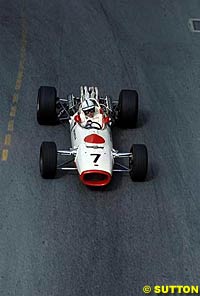 But Surtees' career was not over yet. When Honda approached Surtees at the end of the 1966 season to join
Honda, it was because of all the traits Surtees had that the Honda executives admired: his engineering skills, his fearlessness and skill as first a motorcycle rider and now a Formula One driver, and his ability to bring to Honda some of the English know-how in chassis development that had always been the Honda Grand Prix car's weak point. While a new car, to be called the Honda RA300, was being developed by Surtees at Honda Racing in Slough, England, Surtees was the lone driver for Honda in the 1967 season, still racing the two available RA273 chassis from the prior season. In South Africa at Kyalami, Surtees finished in 3rd place in the 1967 car and, still marking time, finished in 6th at Silverstone and 4th at Nurburgring, two of Surtees' favorite circuits.
But Surtees' career was not over yet. When Honda approached Surtees at the end of the 1966 season to join
Honda, it was because of all the traits Surtees had that the Honda executives admired: his engineering skills, his fearlessness and skill as first a motorcycle rider and now a Formula One driver, and his ability to bring to Honda some of the English know-how in chassis development that had always been the Honda Grand Prix car's weak point. While a new car, to be called the Honda RA300, was being developed by Surtees at Honda Racing in Slough, England, Surtees was the lone driver for Honda in the 1967 season, still racing the two available RA273 chassis from the prior season. In South Africa at Kyalami, Surtees finished in 3rd place in the 1967 car and, still marking time, finished in 6th at Silverstone and 4th at Nurburgring, two of Surtees' favorite circuits.
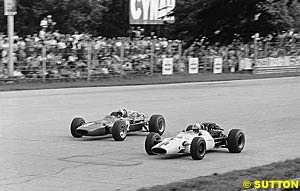 Surtees' Honda was battling with Amon's Ferrari, the powerful Honda thundering down the straights faster than the Ferrari but getting caught up in the corners. Because of this pattern, the white Honda and the red Ferrari were frequently alongside of one another on the main straight, causing pandemonium in the crowd, even though the two cars were only fighting for 4th place.
Surtees' Honda was battling with Amon's Ferrari, the powerful Honda thundering down the straights faster than the Ferrari but getting caught up in the corners. Because of this pattern, the white Honda and the red Ferrari were frequently alongside of one another on the main straight, causing pandemonium in the crowd, even though the two cars were only fighting for 4th place.
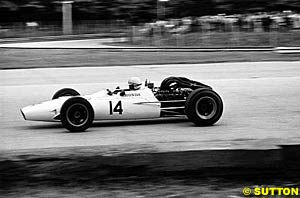 At Curva Grande, the superfast right hander, Clark's engine cut out, the fuel pickup mechanism having failed, and Brabham and Surtees took evasive action as the Lotus twitched sideways, with Surtees coming out ahead of the dodgems in front of Brabham as Clark's fuel-starved engine coughed along in 3rd place.
At Curva Grande, the superfast right hander, Clark's engine cut out, the fuel pickup mechanism having failed, and Brabham and Surtees took evasive action as the Lotus twitched sideways, with Surtees coming out ahead of the dodgems in front of Brabham as Clark's fuel-starved engine coughed along in 3rd place.
|
Contact the Author Contact the Editor |
Please Contact Us for permission to republish this or any other material from Atlas F1.
|
Volume 10, Issue 36
Articles
Exclusive Interview with Eddie Jordan
The Tifosi and the Samurai at Monza
Technical Analysis: 2005 Proposals
2004 Italian GP Preview
2004 Italian GP Preview
Italian GP Facts & Stats
Columns
The F1 Trivia Quiz
Rear View Mirror
Bookworm Critique
On the Road
Elsewhere in Racing
> Homepage |